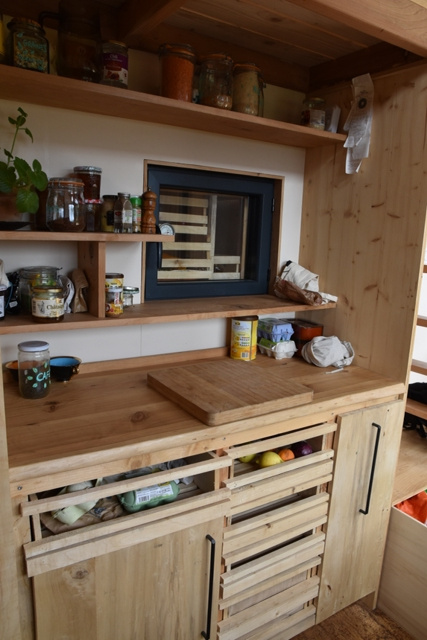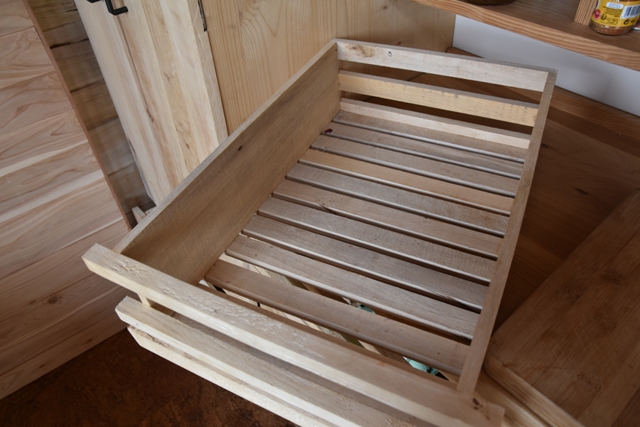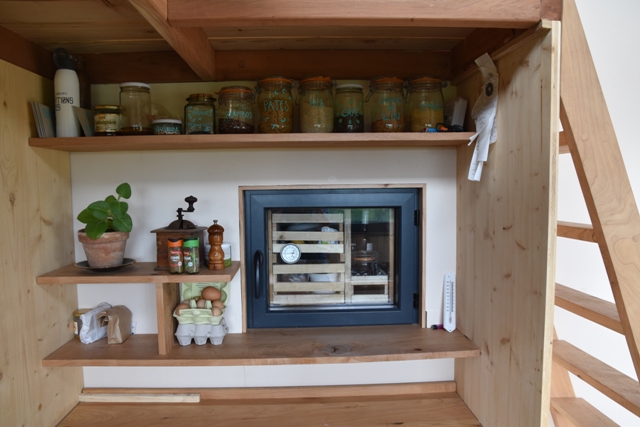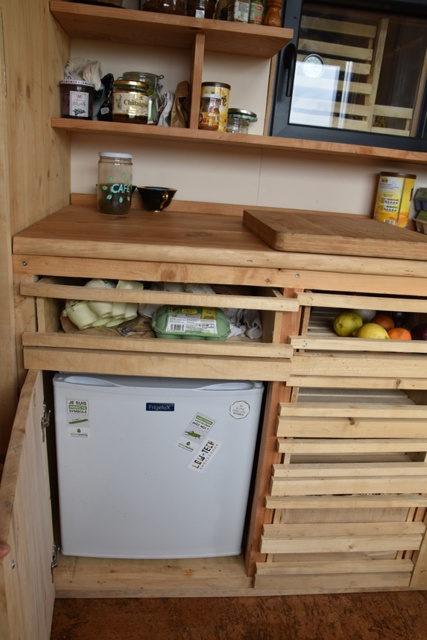| Ligne 79 : | Ligne 79 : | ||
The use of the principle of racks allows for good ventilation, a very important parameter for preserving fruits and vegetables. It can be made using wooden battens (between 2 and 3 cm wide each) or the use of pantry mesh. | The use of the principle of racks allows for good ventilation, a very important parameter for preserving fruits and vegetables. It can be made using wooden battens (between 2 and 3 cm wide each) or the use of pantry mesh. | ||
| − | + | On the entire storage cabinet, an air gap of 3 to 4 cm is to be integrated on the entire back side so that the "exhaust" air and moisture do not stagnate at the bottom at the risk of rotting food faster. | |
}} | }} | ||
{{Tuto Step | {{Tuto Step | ||
Version du 21 mars 2025 à 02:57
Description
Garde-Manger, or pantry storage, enabling optimal environmental conditions by food type
Sommaire
Sommaire
[masquer]- 1 Description
- 2 Sommaire
- 3 Introduction
- 4 Étape 1 - The "Zero Waste" Approach
- 5 Étape 2 - General Information on the Food Storage System
- 6 Étape 3 - Environment 1: Dry, Ventilated, In Room Light
- 7 Étape 4 - Environment 2: Dry, Ventilated, Dark
- 8 Étape 5 - Environment 3: Dark, Cold, Humid
- 9 Étape 6 - Environment 4: Dark and Cold
- 10 Étape 7 - Climacteric Fruits and Vegetables
- 11 Étape 8 - Overview Table
- 12 Notes et références
- 13 Commentaires
Introduction
A Quick Overview of Food Waste
Worldwide, 1/3 of total food production is thrown away.
In France, this represents 10 billion kilograms of food wasted each year, and the carbon impact of these losses is equivalent to 5 times the domestic air traffic.
The analysis of waste shows that 33% of it is done on the last link in the chain: the consumer.
The losses represent an overall cost of €160/year/person.
Quantitatively, fruits and vegetables constitute the most substantial losses (50%).
However, though they represent only 6%, animal products (meat, fish, dairy) represent the largest financial loss.
Causes of Food Waste
In order to design the right solutions to implement to reduce waste, an analysis of its causes is of interest:
• Sociological causes: Our life rhythms, family structures, and ways of organizing our days and meals are changing. We are more hurried and less attentive, which leads to food waste.
• Cultural causes: Our perceptions of food, our aesthetic criteria, and our way of eating lead us to dismiss products that are nevertheless consumable.
•Poor knowledge of food preservation: Keeping is not synonymous with being cold, so a refrigerator is not made to accommodate all food. In addition, confusions arise between terms such as "Use by," "Best-Before," and "Expired by."
•Organizational problems: We lack organization before doing our grocery shopping, to question needs and to buy the appropriate quantities. Refrigerators and cabinets are equally sources of numerous losses due to poor storage that encourages the stacking new foods in front of older ones.
It is important to note that many of these causes can be corrected by good practices that anyone can implement. Technical solutions can be of support, mainly for:
•Creating the right storage environment for each type of food
•Promoting visibility of products
•Making products more easily accessible.
Étape 1 - The "Zero Waste" Approach
The first step in using a food-storage system, such as the one proposed here, is for the user to question the ways in which they buy and consume.
Given that food storage modules that we're going to propose below are mainly designed for raw and fresh foods, it would be difficult for the user eating prepared dishes to benefit from the technical suggestions provided, for example.
The "Zero Waste" approach, originating from Franco-American Béa Johnson, is an excellent method to implement which also allows a significant reduction of waste produced globally (packaging, plastic, etc).
Zero Waste France is a very good resource for complementary information on helping consumers take action.
Étape 2 - General Information on the Food Storage System
In view of the waste that fruit, vegetables, and animal products represent, it is mainly these types of food that we must work on, therefore on short-term preservation.
Preserving does not mean keeping cold, but preserving the nutritional quality and taste of the foods.
As such, several storage environments are worth keeping in mind for a built food storage solution.
Generally, for all short-term storage environments, the most interesting basic technical proposal, in our experience, is the rack drawer.
It is a technical solution that can be easily integrated into a kitchen, permits direct visibility of all contents, and facilitates easy access to all foods, as opposed to a cupboard or a refrigerator.
The use of the principle of racks allows for good ventilation, a very important parameter for preserving fruits and vegetables. It can be made using wooden battens (between 2 and 3 cm wide each) or the use of pantry mesh.
On the entire storage cabinet, an air gap of 3 to 4 cm is to be integrated on the entire back side so that the "exhaust" air and moisture do not stagnate at the bottom at the risk of rotting food faster.
Étape 3 - Environment 1: Dry, Ventilated, In Room Light
We'll find our way around here by use of example: Apricot, eggplant, avocado, banana, citrus, tomatoes, as well as eggs or butter in a butter dish if it's not too hot.
In a kitchen for 2 people, we propose 2-3 grated drawers, measuring 15cm height by 40-50cm depth by 50cm width.
It is designed so that the front and back of the drawer allow for air circulation.
Étape 4 - Environment 2: Dry, Ventilated, Dark
This food-keeping environment is useful notably for potatoes, onions, garlic, squashes, etc. The dark atmosphere prevents the germination of tubers and roots and limits the ripening of certain fruits.
In a kitchen for 2 people, we propose 2 grated drawers lined with a fabric such as linen or jute, to create darkness while ensuring ventilation.
About 25cm height, 40-50cm depth, and 50cm width. They must be made a bit taller than the previous environment to be able to store carrots. They will be kept vertically in a box of slightly moistened sand in one of the drawers.
Étape 5 - Environment 3: Dark, Cold, Humid
For an existing living space:
This environment is the most difficult to create in an existing space; however, it is very useful as it can allow you to keep the refrigerator off for a part of the year.
For existing spaces indoors, we can draw inspiration from the desert refrigerator, or the "zeer pot."
It is essentially made of one pot nested within a second. Sand is added between the two. The foods are placed in the central pot and the sand is regularly moistened. By evapo-transpiration, the interior temperature can drop between 5-10°C (41-50°F) lower than the room temperature.
For a new living space:
In the case of a new living space, we can imagine the old Parisian pantries or "garde-mangers" with boxes opening to the outside--to the north--via a window dedicated to this usage. (Or in a non-insulated partition in this place).
In this environment, you can store artichoke, cucumber, beans, parsnip, butter during mid-season, etc.
For sizing, an interior volume of 40L divided in two is suitable (for example 40cm height, 40cm width, and 30cm depth).
Étape 6 - Environment 4: Dark and Cold
This environment is made using a refrigerator. The idea is to work to reduce the size of it, however, by keeping only leftovers, dairy, meat, fish, and cold beverages inside.
Another positive effect of reducing the size is that it directly reduces electricity consumption.
For two people, we propose the use of a 40L refrigerator (bar style). Depending on the allotted budget, we could find a drawer refrigerator that allows a direct view of all contents; however, they are noticeably more expensive.
Be careful, however, to choose a refrigerator where the vertical storage of standard-sized bottles is possible for more functionality.
Avoid placing the refrigerator next to the oven (which is the case in many kitchens) for more efficiency.
Heat released from the back of the refrigerator into the air gaps of the food storage rack will benefit the circulation of air and humidity of the whole the storage system.
Étape 7 - Climacteric Fruits and Vegetables
In addition to the environments, a second factor comes into play in keeping fruits and vegetables fresh: whether or not they emit ethylene, a gas that promotes ripening, and whether or not they are sensitive to it.
Fruits and vegetables that produce ethylene and that continue to ripen after harvest are called "climacteric," while others can be very sensitive and rot more quickly upon contact with ethylene.
A simple rule is to keep foods that release ethylene separate from those that are sensitive to it. This is why it's good to have at least two drawers per environment and that they're rather large and ventilated, so the ethylene can properly escape.
Étape 8 - Overview Table
| Environment by Food Type | Short-term Food Storage Environment | Climacteric Factor | ||||
| Food Types | Cool, Humid and Dark | Dry, Ventilated, In Room Light | Dry, Ventilated, In the Dark | Other? | Ethylene Producer | Sensitive to Ethylene |
| Apricot | x | x | x | |||
| Garlic | x | |||||
| Pineapple | x | |||||
| Artichoke | x | |||||
| Asparagus | x | Refrigerator Crisper | ||||
| Eggplant | x | x | ||||
| Avocado | x | x | x | |||
| Banana | x | x | x | |||
| Chard | x | |||||
| Beet | x | |||||
| Broccoli | x | Refrigerator Crisper | x | |||
| Carrot | x | x | ||||
| Celery | x | |||||
| Cherry | x | x | ||||
| Mushroom | x | |||||
| Cauliflower | x | Refrigerator Crisper | x | |||
| Cabbage | x | |||||
| Lemon | x | |||||
| Pumpkin | x | |||||
| Clementine | x | |||||
| Cucumber | x | x | x | |||
| Coriander, Cumin | x | |||||
| Squash | x | |||||
| Zucchini | x | x | ||||
| Shallot | x | |||||
| Endive | x | Refrigerator Crisper | x | |||
| Strawberry | x | |||||
| Legumes (beans, lentils) | x | |||||
| Seed Spices | x | |||||
| Green Beans | x | Refrigerator Crisper | x | |||
| Kiwi | x | x | ||||
| Mango | x | |||||
| Melon | x | x | x | |||
| Blackberry | x | |||||
| Turnip | x | |||||
| Onion | x | |||||
| Orange | x | |||||
| Parsnip | x | |||||
| Watermelon | x | |||||
| Sweet Potato | x | |||||
| Peach | x | x | x | x | ||
| Parsley, Chives, Mint, Fresh Coriander, Dill, | In a glass of water | |||||
| Pear | x | x | x | x | ||
| Leek | x | |||||
| Pepper | x | x | x | |||
| Pomelo | x | |||||
| Apple | x | x | x | |||
| Potato | x | |||||
| Plum | x | x | x | x | ||
| Radish | x | |||||
| Grapes | x | |||||
| Arugula | x | |||||
| Lettuce | x | x | ||||
| Tomato | x | x | x | |||
| Leftovers | Refrigerator | |||||
| Dairy | Refrigerator | |||||
| Meat and Fish | Refrigerator | |||||
Notes et références
By Pierre-Alain Lévêque for Low-tech Lab, August 2019
English translation : Katherine Krussel
Italian translation : Samou
Published





 Français
Français English
English Deutsch
Deutsch Español
Español Italiano
Italiano Português
Português